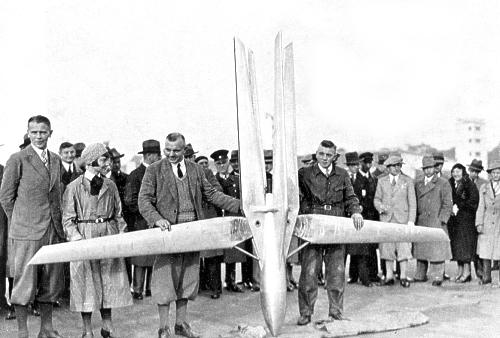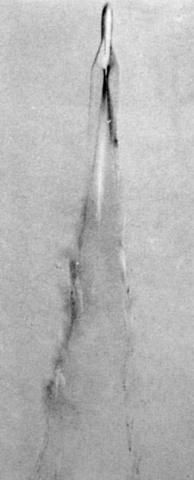
Home - Search - Browse - Alphabetic Index: 0- 1- 2- 3- 4- 5- 6- 7- 8- 9
A- B- C- D- E- F- G- H- I- J- K- L- M- N- O- P- Q- R- S- T- U- V- W- X- Y- Z
Tiling, Reinhold

Tiling
Born: 1893. Died: 1931-04-15. Height: 2.70 m (8.80 ft). Diameter: 0.20 m (0.65 ft). Span: 3.80 m (12.40 ft). Apogee: 0.80 km (0.49 mi).
German rocket pioneer who developed wing-recovered powder rockets. Tiling was inspired to pursue rocketry when he heard Oberth lecture on the subject in 1924. He was impatient to proceed with development of rocket control systems, and didn't want to wait for development of the liquid rocket engine. Therefore he proceeded to work on rockets powered by compressed black powder. In 1928 he began development of rockets with deployable wings for recovery and reuse. In 1929 he received funding from the German Navy, ostensibly for development of improved line-throwing rockets for ship-to-ship transfers. By 1931 his rockets were being fired to 7 km altitude and demonstrating stable flight through use of tail fins. He demonstrated the first launch of a rocket from an airplane in 1932, and in the same year was demonstrating variable wing deployment and parachute recovery of rockets. By 1933 he was demonstrating powder rockets with burn durations of as much as ten seconds. He was killed that same year in an explosion. His brother, Richard Tiling, continued his work for a time, conducting flight experiments at Cuxhaven in the summer of 1934. But further private development of rocketry in Germany was prohibited by the new Nazi government later that year.
Country: Germany. Bibliography: 47, 6111.
 | Tiling |
 | Tiling |
1931 April 15 - . Launch Site: Osnabrueck. Launch Vehicle: Tiling.
- Tiling rocket - . Nation: Germany. Related Persons: Tiling. Apogee: 0.80 km (0.50 mi). Reinhold Tiling, financed by Baron von Ledebour, publicly demonstrates his compressed black powder rocket design at Osnabrueck. The 1.8 m long rocket uses flip-out wings for recovery, and reach altitudes of 800 m..
1933 October 10 - .
- Death of Reinhold Tiling - .
Nation: Germany.
Related Persons: Tiling.
German rocket pioneer, developed wing-recovered powder rockets. Inspired by Oberth lecture in 1924. By 1931 demonstrated stable flight to 7 km, first rocket launch from airplane 1932. By 1933 he had demonstrated his rockets to a small crowd at Tempelhof Airfield in Berlin, but the rest of the event was called off by police after one of his first shots went into the grandstands. In his propellant processing room, where he uses his proprietary process to compress black powder into solid rocket propellant, a fire breaks out. Tiling, and his assistant Angelika Buddenboehmer, are killed.
Back to top of page
Home - Search - Browse - Alphabetic Index: 0- 1- 2- 3- 4- 5- 6- 7- 8- 9
A- B- C- D- E- F- G- H- I- J- K- L- M- N- O- P- Q- R- S- T- U- V- W- X- Y- Z
© 1997-2019 Mark Wade - Contact
© / Conditions for Use